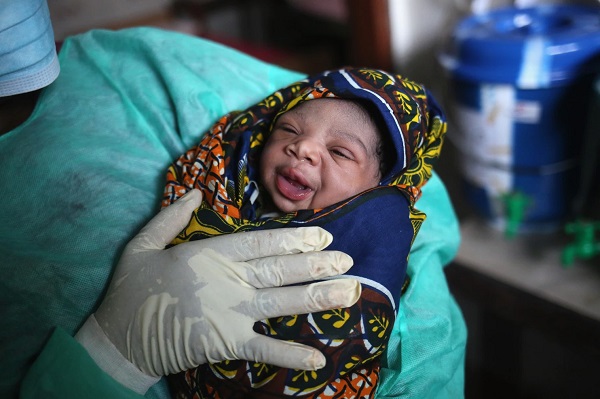
Midwife Maima Johnson holds a newborn girl after delivering her at the Star of the Sea Health Center on January 29, 2015 in the West Point township of Monrovia, Liberia. (John Moore/Getty Images)
DAR ES SALAAM, Tanzania
At a health center here, a young woman is in the recovery room after a Caesarean section. A nurse takes the newborn to a table for cleanup. We (a group organized by the Center for Strategic and International Studies) are allowed to enter and see the child. But she starts struggling for breath. Three more nurses enter. One briefly applies bag-and-mask ventilation. Yet the infant’s breathing grows weaker and weaker as she turns a horrible shade of gray.
The suddenness of this little girl’s death, so soon after her welcome to the world, made it seem particularly cruel. To the nurses, however, it was hardly unusual. Later I was told that Tanzanian mothers often do not name their babies until long after birth, trying to avoid emotional attachment in a place where neonatal, infant and child mortality rates are so high.
I still don’t know what to make of the experience, except to pray for a woman and an innocent little soul and to realize that “neonatal mortality” is not something abstract. It happens in some room, on a table, under a heat lamp, where life’s best gift turns gray and cold.
Tanzania (along with much of the world) has made rapid progress in reducing child mortality — defined as children younger than 5. In one region I visited, rates have fallen by more than half during the past five years.
With the help of Gavi — the global vaccine alliance — vaccination rates in Tanzania are north of 90 percent, and new rotavirus and pneumococcal vaccines are arriving. Women walk and bicycle for miles to have their children vaccinated, while some American suburbanites engage in vaccine denialism. Tanzania’s vaccination rate for measles is higher than America’s. With the help of the President’s Malaria Initiative and the Global Fund, Tanzania is making progress against malaria, which is particularly dangerous for pregnant mothers and children younger than 5.
The combination of these and other high-impact interventions is dramatically reducing child mortality. But newborn and maternal mortality rates in Tanzania remain stubbornly high. The reasons are numerous and interlocking. Even before pregnancy, women suffer disproportionately from malnutrition (often last in line for food, I was told by one physician, behind their fathers and brothers). Before delivery, checkups often don’t include basic tests for hemoglobin levels (to diagnose anemia) and high blood pressure (to identify preeclampsia). When labor starts, it is difficult for women in rural areas to travel to health facilities — consider the prospect of being carried by bicycle, at night, along dirt roads, with contractions.
Once at the clinic or hospital, women generally are required to provide their own sheets, food and medical supplies. The cost of health services causes some Tanzanian women to turn to traditional healers. If serious complications at health centers arise during delivery, the supply of blood for transfusions is very limited. Hemorrhages are the leading cause of maternal death worldwide. Children born in distress sometimes receive minimal attempts at resuscitation.
Addressing these problems is complex. It will require the development of blood banks; expanding the number of facilities capable of dealing with high-risk pregnancies; bringing women on the verge of delivery closer to services (as Tanzania has begun doing with maternity homes near hospitals). Lowering maternal mortality will also involve improved access to family planning so women can safely space their pregnancies. (The odds of hemorrhage, infection or rupture increase dramatically when births come early in life, late in life or in rapid succession.)
Much of this can be categorized as health-system strengthening. But the best way to strengthen a health system (as we’ve seen in vaccination campaigns and efforts to fight AIDS and malaria) is to pick and pursue an ambitious, achievable health goal.
The reduction of maternal and newborn mortality is ripe for this kind of concerted international effort. Last year, the World Bank, Canada, Norway and the United States announced the creation of a Global Financing Facility, dedicated to ending preventable maternal, newborn, child and adolescent deaths by 2030. But the effort remains shapeless.
At a rural clinic near Mwanza, I met a woman who had just given birth. Her first child, I learned, had died of malaria. Her second was stillborn at full term. Through an interpreter, I asked the name of the healthy girl lying beside her. The interpreter assured me that Tanzanian women don’t name children so early but asked my question anyway.
“Mhinga,” she told me. “Her name is Mhinga.”
A life, a gift, a name.
